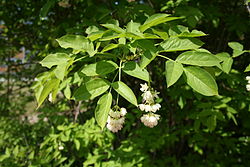| Staphylea pinnata | |
|---|---|
 | |
| Scientific classification | |
| Kingdom: | Plantae |
| Clade: | Tracheophytes |
| Clade: | Angiosperms |
| Clade: | Eudicots |
| Clade: | Rosids |
| Order: | Crossosomatales |
| Family: | Staphyleaceae |
| Genus: | Staphylea |
| Species: | S. pinnata |
| Binomial name | |
| Staphylea pinnata L. | |
Staphylea pinnata, the European bladdernut, [1] is a species of bladdernut native to Europe and naturalized in Britain. [2]